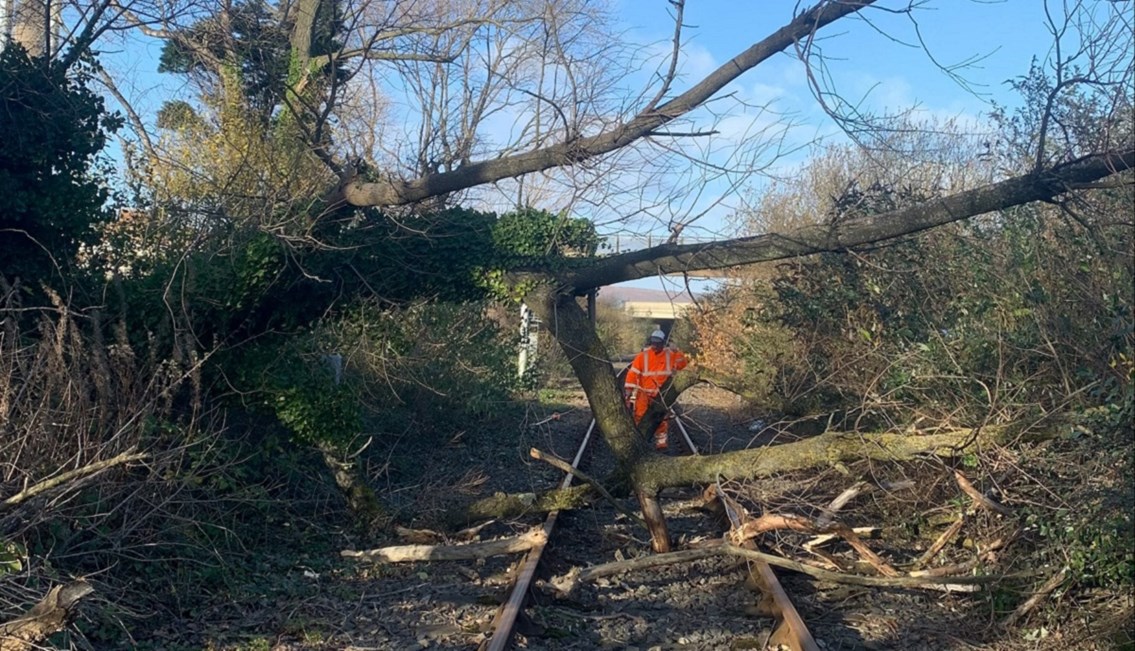Thursday 9 Dec 2021
‘Tree-mendous:’ How Network Rail's biggest ever tree survey in Wales is improving railway safety and biodiversity
- Region & Route:
- Wales & Western: Wales & Borders
Every mile of track is being inspected across Wales to detect and remove hazardous trees and help save a threatened species
Since September 2020, 35 trains have hit a fallen tree or branch on the railway in Wales and there were a total 112 reports from train drivers and railway staff of fallen trees or branches on the track. Many trees end up on the track as a result of high winds during Winter storms. The recent Storm Arwen brought 81mph winds across parts of Wales.
Hazardous trees present a huge safety risk for the railway, putting passengers and train staff in danger. They also result in long delays and disruption to passenger and freight services when engineers are called out to remove them from the track.
To help tackle this rising issue, Network Rail Wales & Borders is carrying out its biggest ever tree survey to identify and safely remove as many hazardous trees alongside the railway, as safely as possible. This huge task, which began in summer 2020, is expected to take around two years to complete and involves the inspection of almost 1,000 miles of track.
The main concern of Network Rail's environmental specialists is the presence of ‘ash dieback’: a fungal disease that scientists predict will threaten up to 80% of the species. A Europe-wide problem, the fungus prevents water and nutrients from flowing throughout ash trees and causes the tree to slowly die.
To help prevent the spread of ash dieback, Network Rail tree surgeons will work to remove only the infected ash trees, allowing the genetically resistant ones to flourish and repopulate the species; less competition means more light and space for the healthy trees to grow.
To maintain and increase biodiversity, the teams will leave the trunks of the removed trees to become homes for roosting bats and more than 62 species of lichen; three of which are endangered.
Network Rail is also looking at replanting schemes on their land to establish native species with ‘high-habitat value’ and aim to match the number of trees removed. All the lineside sites where hazardous trees were removed will be passed onto environment and ecology teams to determine whether replanting schemes will be suitable.
Mitchell Pether, asset engineer at Network Rail, said:
“Our top priority is safety, so removing these trees succumbing to ash dieback is crucial in order to protect the line, our passengers and staff.
“We also want to minimise disruption for passengers and freight users while maintaining our green corridor, so this isn’t just about cutting down ever lineside tree, it’s a targeted and proactive approach that will protect the line and increase biodiversity.”
Alexia Course, Transport for Wales’ Director of Transport Operations, said:
“As we have recently seen with Storm Arwen, extreme weather is making it more challenging than ever to run a safe and reliable railway in Wales and the borders.
“The removal of hazardous trees is essential in keeping passengers and our train drivers safe. The removal will also help us minimise delays and disruptions and will ensure that our customers receive the service they deserve.’
Natural Resources Wales is in support of the survey being carried out by Network Rail.
Andrew Wright, specialist advisor, Natural Resources Wales, said:
“Ash Dieback is one of the most significant tree diseases to affect the Welsh landscape, ash trees affected by this disease potentially pose a significant health and safety risk and we understand the measures taken by Network Rail to reduce the risks and welcome any work to recover lost biodiversity.”
Notes to Editors
Last weekend’s Storm Arwen was a powerful reminder of the growing impact and problem of extreme weather on the Wales and Borders network. There were 41 weather related incidents reported including 20 trees falling on the track and the rest involving debris on the railway or branches causing obstruction.
Trees affected by ash dieback are vulnerable to 40mph winds; Storm Arwen was producing 81mph winds. Another reminder of the need to remove these hazardous trees due to increasing extreme weather events.
Interview requests with our maintenance lineside team are welcome.
Contact information
Passengers / community members
Network Rail national helpline
03457 11 41 41
Latest travel advice
Please visit National Rail Enquiries
Journalists
Callum Jones
callum.jones2@networkrail.co.uk
About Network Rail
We own, operate and develop Britain's railway infrastructure; that's 20,000 miles of track, 30,000 bridges, tunnels and viaducts and the thousands of signals, level crossings and stations. We run 20 of the UK's largest stations while all the others, over 2,500, are run by the country's train operating companies.
Usually, there are almost five million journeys made in the UK and over 600 freight trains run on the network. People depend on Britain's railway for their daily commute, to visit friends and loved ones and to get them home safe every day. Our role is to deliver a safe and reliable railway, so we carefully manage and deliver thousands of projects every year that form part of the multi-billion pound Railway Upgrade Plan, to grow and expand the nation's railway network to respond to the tremendous growth and demand the railway has experienced - a doubling of passenger journeys over the past 20 years.
Follow us on Twitter: @networkrail
Visit our online newsroom: www.networkrailmediacentre.co.uk

